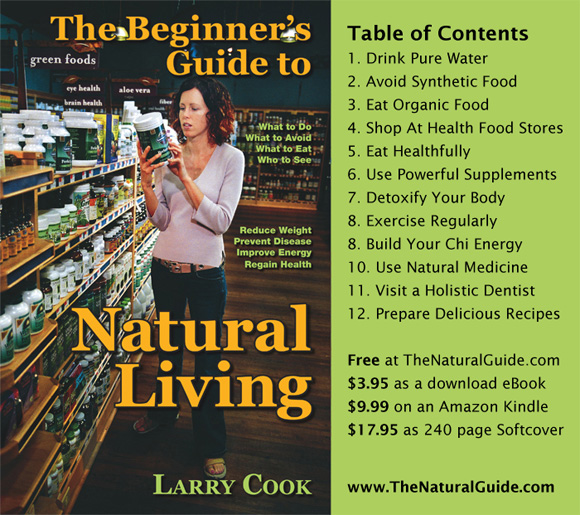|
|
Avoid Synthetic Food
Part 9: Monosodium Glutamate (MSG)
“MSG is a drug added to our foods that causes widespread toxicity.” ~George R. Schwartz, M.D
In many Philippine provinces, as in the rest of Asia, it is not uncommon for people to eat dogs, after poisoning them with one or two tablespoons of monosodium glutamate (MSG) placed inside a roll of bread. The dog salivates, loses consciousness and involuntarily spasms until breathing stops. MSG is a drug.
|
|
|
It has no flavor of its own and synthetically enhances the taste of food by altering the way the tongue, nervous system and brain communicate with one another. It intensifies the flavor of savory foods by causing neuron cells in the mouth to over-react to different flavors. Unfortunately, these over-stimulated cells exhaust themselves and die, causing microscopic scarring throughout the human system. Within 30 minutes of eating processed foods high in MSG, neurons swell up like balloons and die after three hours. With lower doses, neuron cells die after 18 to 24 hours.
Yet, you’ll find MSG in the spice section of your local supermarket. It’s in many seasoning mixes and is used in most processed foods—candy, cakes, donuts, dairy products, snack foods, frozen entrées, salad dressings and soups, to name a few. It is often disguised under different names, such as hydrolyzed protein, sodium caseinate or calcium caseinate, gelatin, textured protein, carrageenan or vegetable gum. Still more is hidden in flavorings of all kinds (including chicken, beef, pork, smoke and even “natural” flavorings), bouillon, broth or stock, malt extract, malt flavoring, whey protein, whey protein isolate or concentrate, soy protein, soy protein isolate or concentrate, soy sauce or extract, “zest,” “gourmet powder,” and more.
MSG was first developed in Japan in 1909, and soon gained widespread acceptance in the Orient. In 1948, it was introduced to the American food industry as a flavor enhancer for otherwise bland food products, during a national convention in Chicago, attended by all the major food producers, including Campbell Foods, Continental Foods, General Foods, Nestles, United Airline Food Service, Libbey, Pillsbury and Oscar Mayer.
Live Naturally: Improve Your Health Today

In a 1974 questionnaire, Dr. Liane Reif-Lehrer, a noted researcher at Harvard Medical School, investigated people’s reactions to MSG. Almost 30 percent of the 1,529 respondents reported dizziness, nausea, abdominal pain, visual disturbances, fatigue, shortness of breath, weakness, headache or tightness around the face. Emotional reactions ranged from depression and insomnia to “feeling tense.”[vii]
More than 500 million people worldwide and approximately 5 percent of Americans react severely to very small amounts of MSG, and up to 30 percent have a noticeable reaction. Many scientists and researchers label MSG as a neurotoxin and suggest that it may contribute to Alzheimer’s and Lou Gehrig’s Disease, Huntington’s Chorea, Parkinson’s Disease and other neurological diseases.
A reaction may be caused by as little as 1/10th of a teaspoonful (1/2 gram). Many packaged meals contain three grams or more. Common reactions include dizziness, headache, flushing and burning sensations.[viii] The more we ingest, the greater the reaction, which in rare instances is fatal. Infants, senior citizens, asthmatics, people with neurological and immune disease health challenges, heart or digestive tract problems and severe mood or depression problems are most at risk.
More than 10 years ago psychiatrist Dr. John Olney from Washington University in St. Louis said during a neuroscience meeting that, “Over 20 years ago [over 30 now] glutamate was shown to cause brain damage to infant animals. Since then, it has become increasingly evident that glutamate and closely related substances are neurotoxins that can cause human neuro-degenerative diseases.”[ix] Dr. Olney conducted studies on rodents and found that MSG damaged the hypothalamus gland. It also caused obesity, behavioral and endocrine changes, stunted bodies and caused seizures and infertility. Hypothalamic neurons responsible for growth regulation, puberty onset, memory and learning, endocrine functions, appetite and circadian rhythms were destroyed.[x] He also discovered that children typically get enough MSG in one bowl of commercial soup to raise blood glutamate levels to those found to cause severe brain cell damage in experimental animals.[xi]
MSG is never safe—even if you don’t react to it. Avoiding all forms of MSG is the best choice for those who desire vibrant health.
>>> Go To Chapter 3: Organic Food
Notes
[i] In Bad Taste–The MSG Symptom Complex, George R. Schwartz, M.D., p. 2.
[iv] Experimental studies show that glutamate acts as a trigger that opens the sodium channel on the cell membrane and allows calcium to enter the neuron, triggering an enzyme called phospholipase C within the cell, which then triggers the release of arachidonic acid, damaging the cell’s interior. The arachidonic acid is attacked by two enzymes called lipoygenase and cyclo-oxygenase, further triggering an explosive release of free radicals (superoxide and hydroxyl radicals) which brings on cell death. The normal concentration of antioxidants in the brain is not enough to handle the excess free radicals produced in this way. The Leading Edge Research Group, www.trufax.org.
[vi] In Bad Taste – The MSG Symptom Complex, George R. Schwartz, M.D., p. 9.
[vii] In Bad Taste – The MSG Symptom Complex, George R. Schwartz, M.D., p. 13; Federation Proceedings, April 1977.
[viii] The Feel Good Handbook, Annie Costa, The Lighthouse Press, http://thelighthousepress.com.
[ix] Society for Neuroscience 19th Annual Meeting, Phoenix, Arizona, October, 1989; The Psycho-Social, Chemical, Biological and Electromagnetic Manipulation of Human Consciousness, Val Valerian, Leading Edge Research Group, p. 175.
|
|